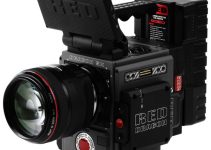One of the nice features that sets apart the Blackmagic Pocket Cinema Camera 4K from the other competitors is its audio inputs. To be fair, it’s hard to define a real competitor for a camera that markets as a Cinema Camera, and as such prone to some compromises, other than the mirrorless cameras or DSLRs due to the price tag.
That would be actually an apples to oranges comparison, but we could say that at least they come in the same basket. Sporting two inputs, a regular 3.5mm jack, and a mini-XLR, the Pocket 4K places itself in a nice spot for audio work on set. Let’s hear from an audio guy like Curtis Judd about it.
The first input we come around, as we do on many other cameras, is the 3.5mm jack. There’s a little downside to this, though. The jack does not provide plug-in power. What does that mean you may wonder? It means it can not feed power to the mic you attach to it, and unfortunately, this includes the vast majority of lavalier mics.
You can instead tether a mic like the Rode VMP so to get scratch audio on camera, thanks to the 9V battery inside it. Vloggers may see the absence of power as a bummer, but to be honest, this camera is not really aimed to vloggers.
It’s, in fact, a cinema camera, and that is clear once you realize that the jack is a timecode input, allowing for a sync device like the Tentacle Sync E Timecode Generator to have true timecode sync, that makes it a breeze to sync up your clips during editing. A very rare feature in cameras at this price.
If you need to operate through the 3.5mm jack you can use an external adapter like the Saramonic SR-PAX2. Useful tip. If you want to have two mics on separate tracks you can pan one all to the left and the other all to the right, and you’ll have more flexibility in post.
So we already mentioned the mini-XLR port. But what makes it so special? Once you hooked up the adapter to standard XLR you can cover longer distance due to the signal being balanced and as such less easily disturbed by electromagnetic interferences.
You can have a mixer to input all your mics and manage the peak levels, but then send a mixdown to the camera through the XLR line. Keep in mind though that since you’ll deal with a single input, it will be a mono signal.
That’s not too bad, although it’s recommended to have two XLR inputs, you can still use it as a good reference. The port provides phantom power and while testing a good variety of mics, Judd got some interesting results on the preamps inside the Pocket 4K.
The noise floor, once the audio has been normalized to -23 LUFS (and that is a broadcasting standard), hits between -71 to -73db, which seems to be a very good result. The same is not true for a condenser mic, but at the same time that is not a kind of mic one would normally use on a cinema camera.
The preamps seem to do quite well, comparable, if not better, to a Zoom H4n field recorder. They are quite neutral, not adding to the recorded sound any kind of artifacts. Obviously, performance cannot match a higher end sound device, but still, a very good choice to have if you need to shoot an interview or something similar.
Blackmagic Design Pocket Cinema Camera 4K Highlights
- 4/3″-Sized HDR Sensor
- Record DCI 4K 4096 x 2160 up to 60 fps
- Dual Native ISO to 25,600
- 5″ Touchscreen Display
- Active Micro Four Thirds Lens Mount
- Record up to 120 fps Windowed HD
- CFast 2.0 & SD/UHS-II Card Slots
- External Recording via USB Type-C
- 13-Stop Dynamic Range, 3D LUT Support
- Includes DaVinci Resolve Studio License
[source: Curtis Judd]
B&H Order Link:
Blackmagic Design Pocket Cinema Camera 4K
Disclaimer: As an Amazon Associate partner and participant in B&H and Adorama Affiliate programmes, we earn a small comission from each purchase made through the affiliate links listed above at no additional cost to you.


